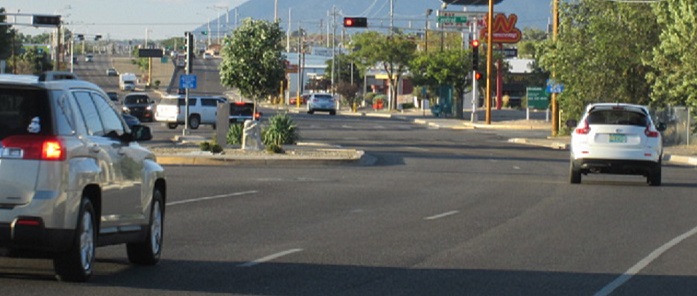
Rosalie Rayburn’s fine story at the Albuquerque Journal on Olivier Kamndon, the Central African Republic refugee struck while walking across Montgomery near Carlisle, illustrates the importance of personalizing pedestrian crash victims.
Mr. Kamndon’s story of successfully fleeing, after incredible hardship, the war-torn C.A.R., only to be nearly killed by a driver in the NE Heights, is compelling, sad and well-told. One, of course, very much wishes a quick and complete recovery for Mr. Kamndon, and, while wishing that, also hopes that his compelling story can influence the driving behavior of at least a few Burque residents.
As has been something of a mantra here at Better Burque (and, of course, elsewhere): these folks hit, and too often killed, while walking are human beings. As motorists in our seemingly protective two-ton bubble against humanity, we tend to forget there is even a world, much less plenty of fellow humans, out there beyond the bubble.
Stories such as that of Mr. Kamndon bring us back to the reality that roads are not just an escape from the rest of the world, but an ongoing interaction with it, including other humans who aren’t similarly escaping in metal bubbles to get somewhere. Paying attention to these other humans, particularly non-motorized folks, entails driving in a way that focuses on anticipating those interactions. Yes, that gets in the way of our strong desire to simply get lost in our thoughts, music, texting…
It unfortunately appears to be the case that Mr. Kamndon’s attacker, there’s really not a better word for it, was too lost in thought, or worse, to even stop after striking him. 19-year-old Samantha Ramos-Montanez just “continued going west” on Montgomery after the incident.
Fortunately, Ms. Ramos-Montanez was caught and charged with leaving the scene of an accident with great bodily harm. Having studied pedestrian fatalities the last several months, I have found far too many cases in which hit & run pedestrian deaths remain unsolved, and it is disturbing to realize that there are several among us who perpetrated such crimes and fled scenes, just as Mr. Ramos-Montanez did, still freely zooming around on our streets.
I’m a realist. I don’t believe for a second that any of these fugitive hit & run perpetrators will read the story of Mr. Kamndon, ponder their actions and turn themselves in. But maybe, somehow, one or a few of them will at least come across the story. It’s intriguing to imagine their reaction.
Far more likely and ultimately more important is the impact reading about Mr. Kamndon might have on “average” motorists. Most reports of such incidents never get beyond assigning vague blame, “dark clothing at night, not using the crosswalk, etc.,” and we the living use these scant “facts” to somehow feel better about it all.
We “average people” don’t have to know anything else because it’s been “explained.” We can move on to the next story, entertainment, passing thought without really considering the victim’s humanity, without consideration that maybe there’s something fundamentally wrong here and that we should be doing something about that fundamental wrong.
Stories on Mr. Kamndon’s terribly unfortunate plight can help dent this numbed passivity. I applaud Ms. Rayburn for her work in bringing this story to light and hope to see/read/hear more on the devastating personal results such incidents have on these very real humans, their families, friends and colleagues.
[…] on that transit agency’s newly-announced, three-year effort to redesign its bus network. Better Burque praises the Albuquerque Journal for humanizing the victims of traffic violence by reporting on […]
LikeLike
I do not wish to appear to be flippant, but I have had many near misses with pedestrians because they have chosen to weave in and out of traffic, or to jaywalk when a crosswalk is less than 100 feet away, or shoes to cross when the signal says not to.
As a driver we should be attentive, but that doesn’t excuse pedestrians when safety measures are put in place such as crosswalks and signals to safely cross. Since you have mentioned statistics previously, a simple question remains: How many deaths or injuries of pedestrians would have been prevented had they used the crosswalks instead of illegally jaywalking?
If we are to fix that’s very serious problem, the biggest causes need to be addressed as quickly as possible. If using the crosswalk properly would prevent the majority, then pedestrians have a responsibility there. After all, crosswalks and signals are there to prevent the very problem that you’re concerned with in the first place
Obviously, there are other solutions that need to be addressed, such as some parts of the city that don’t have proper sidewalks for safe foot travel. As drivers, we do need to make sure that we’re following speed limits and not following too closely to cars or to sidewalks, but this is an issue that drivers cannot solve alone.
LikeLike